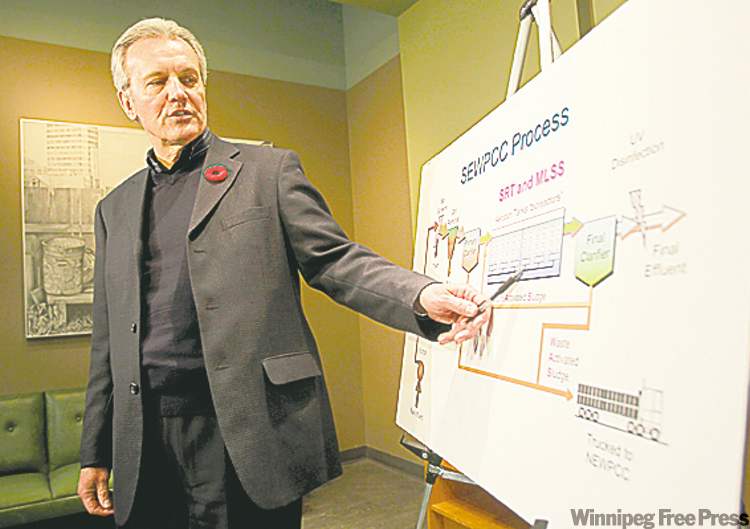Plant stops releasing partly treated sewage
Water treatment facility functioning at 'above 90%'
Advertisement
Read this article for free:
or
Already have an account? Log in here »
To continue reading, please subscribe:
Monthly Digital Subscription
$1 per week for 24 weeks*
- Enjoy unlimited reading on winnipegfreepress.com
- Read the E-Edition, our digital replica newspaper
- Access News Break, our award-winning app
- Play interactive puzzles
*Billed as $4.00 plus GST every four weeks. After 24 weeks, price increases to the regular rate of $19.00 plus GST every four weeks. Offer available to new and qualified returning subscribers only. Cancel any time.
Monthly Digital Subscription
$4.75/week*
- Enjoy unlimited reading on winnipegfreepress.com
- Read the E-Edition, our digital replica newspaper
- Access News Break, our award-winning app
- Play interactive puzzles
*Billed as $19 plus GST every four weeks. Cancel any time.
To continue reading, please subscribe:
Add Winnipeg Free Press access to your Brandon Sun subscription for only
$1 for the first 4 weeks*
*$1 will be added to your next bill. After your 4 weeks access is complete your rate will increase by $0.00 a X percent off the regular rate.
Read unlimited articles for free today:
or
Already have an account? Log in here »
Hey there, time traveller!
This article was published 17/11/2011 (5049 days ago), so information in it may no longer be current.
Sewage treatment at the South End Water Pollution Control Centre is returning to normal after a month-long bioreactor failure.
Effluent samples collected on Nov. 10 reveal the south St. Vital plant is no longer polluting the Red River with fecal coliform bacteria, ammonia and waste particles, water and waste officials announced Wednesday.
“The situation at the south end plant has dramatically improved,” engineering manager Mike Shkolny told reporters Wednesday, almost five weeks after the problem began.

On Oct. 7, city engineers found the biological-treatment component of the plant had failed due to the unexplained death of beneficial bacteria that normally consume organic waste. At the same time, undesirable string-like bacteria grew in the bioreactors and interfered with the clarification of effluent further along in the treatment process.
More than three weeks after the malfunction began, engineers disclosed the problem to politicians and sought advice from outside experts. During this time, the plant discharged 50 million to 60 million litres of partly treated sewage into the Red River every day, leading to elevated downstream levels of fecal bacteria and ammonia.
Finally in November, engineers trucked in beneficial bacteria from the North End Water Pollution Control Centre in an attempt to rejuvenate the south end bioreactors. They also used chlorine to kill the filamentous bacteria and added a polymer to a clarification tank to help settle out waste particles.
This plan proved to be successful by the middle of last week, Shkolny said. Samples from Nov. 10 reveal effluent from the south end plant contained only three to nine parts of E. coli bacteria per 100 millilitres, which is well below the maximum allowed concentration of 200 parts, according to the plant’s provincial licence.
Samples of Red River water downstream from the plant have also improved, Shkolny said. On Nov. 9, fecal coliform concentrations at the Fort Garry Bridge were 93 parts per 100 millilitres, down from 760 parts on Nov. 3. Any concentration above 200 parts is considered unsafe for swimming.
Ammonia levels in the Red River also returned to recommended levels while oxygen levels in the river are well above what’s required to support aquatic life, said Shkolny, who described the plant as functioning at “above 90 per cent” when it came to most sewage-treatment processes.
The plant is still having trouble getting rid of all the materials that can potentially deplete oxygen levels. As a result, engineers will continue adding polymers and chlorine to the plant, Shkolny said.
But there is no need to continue hauling beneficial bacteria from the north end plant to the south end bioreactors, he said.
“The plant at the south end has been rejuvenating and running on its own since Nov. 10,” he said.
The cause of the biological failure remains unknown, though the city suspects illegal dumping of diesel fuel may be a culprit.
“There was some evidence of diesel. We did see a sheen on the surface of the clarifiers, which was analyzed and determined to be diesel. But that’s really one of several avenues we’re pursuing,” Shkolny said.
Only a small amount of diesel can effectively suffocate beneficial bacteria by depriving them of oxygen, Shkolny said. But he insisted the city is still investigating the possibility other pollutants may have played a role.
It will still take a week or two before the plant returns to normal, he said.
Once that happens, the city will review the events of the past six weeks, with an eye to diagnosing and disclosing biological-treatment problems more quickly, said water and waste director Diane Sacher.
The city still faces the possibility of charges under the provincial Environment Act, both because of the month-long discharge and because engineers did not disclose the problem within 12 hours.
Last week, Manitoba Conservation asked the water and waste department to prepare a blow-by-blow account of the south end malfunction.
bartley.kives@freepress.mb.ca

